Smartphones & Tablets | October 10, 2023
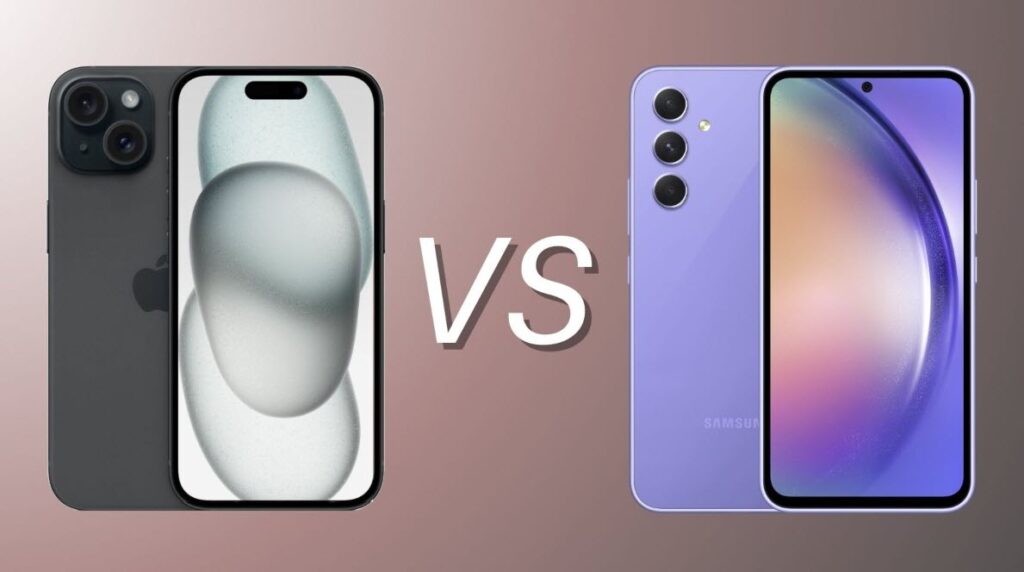
| iPhone 15 | Samsung Galaxy A54 | |
| Screen | 6.1 inches of OLED Super retina Shield | 6.4 inches of Super AMOLED technology, 19.5:9 format, FullHD+ resolution of 2,340 x 1,080 pixels, 120 Hz refresh rate, 240 Hz touch sampling rate, 1,000 nits maximum brightness, HDR10 and Corning Gorilla Glass 5 protection |
| Main camera | – 48 megapixel main sensor with f/1.6 focal aperture, 2X optical zoom and 4K video recording capacity at 60 frames per second – Secondary sensor with 12 megapixel wide-angle lens with f/2.4 focal aperture | – 50 megapixel main sensor with f/1.8 focal aperture with video recording capacity in 4K resolution at 30 frames per second – 12 megapixel wide-angle secondary sensor with f/2.2 aperture and 123° field of view – 5 megapixel tertiary macro sensor with f/2.4 aperture |
| Selfie camera | 12 megapixel main sensor with f/1.9 focal aperture with 4K video recording capacity at 60 frames per second | 32 megapixel main sensor with f/2.2 focal aperture with video recording capacity in 4K resolution at 30 frames per second |
| Internal memory | 128 GB, 256 GB or 512 GB NVMe type | 128 or 256 GB of UFS 2.2 type |
| Extension | Not available | Expandable via microSD card up to 1TB |
| Processor and RAM memory | – 4-nanometer, six-core A16 Bionic chip at 3.46 GHz max. with five-core GPU – 6 GB of RAM | – Samsung Exynos 1380 5 nanometer eight-core 2.4 GHz max. – 6 or 8 GB of LPDDR4 type RAM |
| Battery | 3,877 mAh with 20W fast charging, 15W MagSafe wireless charging and 7.5W reverse wireless charging (charger not included in the box) | 5,000 mAh with support for 25W fast wired charging (charger not included in the box) |
| OS | iOS 17 | Android 13 under One UI 5.1 |
| Connections | 5G, 4G LTE, Wi-Fi 802.11 a/b/g/n/ac/6 dual-band, Bluetooth 5.3, GPS with A-GPS and GLONASS, NFC for contactless payments via Apple Pay, input USB type C and satellite connection | 5G, 4G LTE, dual-band WiFi 802.11 a/b/g/n/ac/6, Bluetooth 5.3, GPS with A-GPS and GLONASS, NFC for contactless payments and USB type C input |
| SIM | Dual nano SIM (nano SIM + eSIM) | Dual nano SIM |
| Design | Colors: black, blue, green, yellow and pink | Colors: black, white, blue and lavender |
| Dimensions and weight | 147.6 x 71.6 x 7.8 mm and 171 grams | 158.2 x 76.7 x 8.2 millimeters and 202 grams |
| Featured Features | Face ID, IP68 waterproof, 4K 30fps cinematic mode for video recording with field blur effect and dual stereo speakers | Under-display optical fingerprint sensor, facial recognition, stereo speakers with Dolby Atmos, and IP67 water and dust resistance (submergence-proof) |
| Release date | Available | Available |
| Price | From 960 euros | From 340 euros |
The iPhone 15 is the most modest phone in the series, but that doesn’t mean it’s not one of the most advanced phones of the year. It was recently introduced as a high-end device with some of the top features in its segment. We’ve already compared it to the iPhone 13 Pro, the iPhone 15 Plus, and the iPhone 15 Pro. However, we haven’t yet pitted it against a Samsung device, so let’s see how it fares against the Galaxy A54 this time. We’ll analyze their differences, as well as their prices, advantages, and disadvantages to determine which one is better and why. To do this, we’ll detail all their features and technical specifications in this comparison of the iPhone 15 vs Samsung Galaxy A54.
Please note that the prices mentioned in this article may vary over time, so we will focus on analyzing the differences as of the publication date.
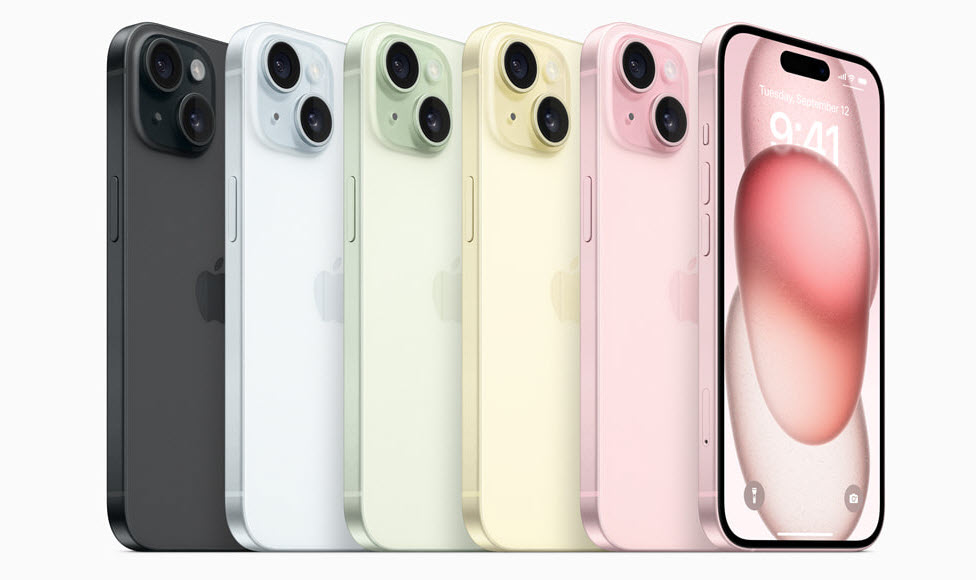
You don’t need to be too detail-oriented to distinguish the iPhone 15 from the Samsung Galaxy A54, as both have designs that are characteristic of their respective brands. The iPhone 15 follows the design language we’ve known since the iPhone 13, with the novelty of adopting the Dynamic Island, a pill-shaped cutout in its display. Additionally, it has a dual rear camera setup that is positioned diagonally.
On the other hand, the Samsung Galaxy A54 features a typical hole-punch cutout for the front camera. It also has a triple rear camera setup aligned vertically, which closely resembles the one found on the Galaxy S23, Samsung’s flagship for 2023.
Both phones have straight edges, but the edges of the iPhone 15 are slightly rounded, making it more comfortable to hold. In terms of build, the iPhone 15 has a textured matte glass back, while the Samsung Galaxy A54 opts for a polycarbonate (plastic) back, which is less premium in comparison. Both phones have plastic frames. It’s worth noting that the iPhone 15 is more compact, thinner, and considerably lighter than the Samsung phone, weighing around 31 grams less.
When it comes to displays, there are significant differences between the iPhone 15 and Samsung Galaxy A54. Starting with the iPhone 15, it features a 6.1-inch Super Retina XDR OLED panel with a Full HD+ resolution of 2,556 x 1,179 pixels (19.5:9 aspect ratio). It also has a 60Hz refresh rate, a maximum brightness of 2,000 nits, and support for Dolby Vision and HDR10 standards. The display is protected by Ceramic Shield glass.
The display on the Samsung Galaxy A54, on the other hand, is a 6.4-inch Super AMOLED screen with a Full HD+ resolution of 2,340 x 1,080 pixels (19.5:9 aspect ratio). It offers a higher 120Hz refresh rate but reaches a maximum brightness of only 1,000 nits, half of what the iPhone 15’s screen can achieve. It also supports HDR10 content but lacks Dolby Vision support. The display is protected by Corning Gorilla Glass 5.
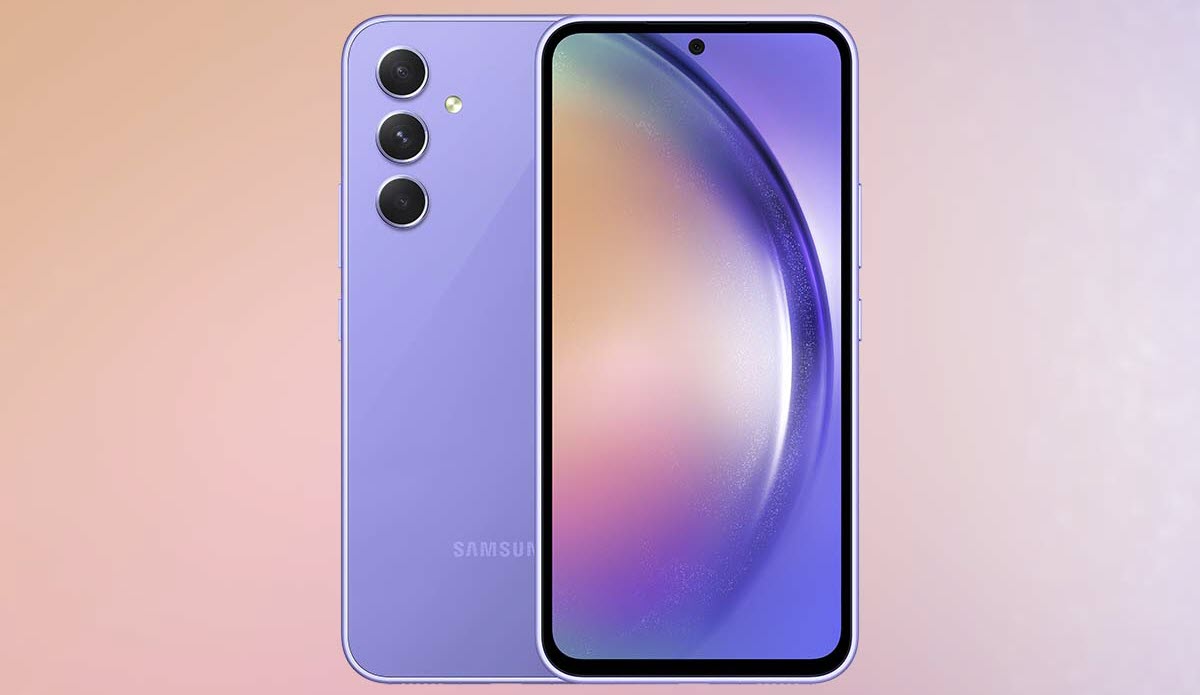
The iPhone 15 is one of the most powerful smartphones currently available, thanks to its A16 Bionic chipset, which offers top-tier performance in the premium high-end segment. This chip can handle any application or game, no matter how demanding they are in terms of graphics and resources. The user experience on the iPhone 15 is fast and smooth, thanks to the A16 Bionic’s 4-nanometer process and six cores that operate at a maximum clock frequency of 3.46 GHz.
The Samsung Galaxy A54, on the other hand, offers good performance but not at the same level as the iPhone 15. Its processor is decent but falls slightly behind in terms of power. It features the Exynos 1380 chipset, which should be more than sufficient for most users and can handle virtually any app without any issues. However, it may struggle when running very heavy and resource-intensive applications and games, resulting in lags and frame rate drops. This chip is built on a 5-nanometer process and features eight cores with a maximum clock speed of 2.4 GHz.
In terms of memory options, the iPhone 15 comes with 6GB of RAM and internal storage options of 128GB, 256GB, or 512GB of NVMe storage, with no support for expansion via microSD. The Samsung Galaxy A54, on the other hand, offers 6GB or 8GB of LPDDR4 RAM and 128GB or 256GB of UFS 2.2 internal storage, which can be expanded using a microSD card.
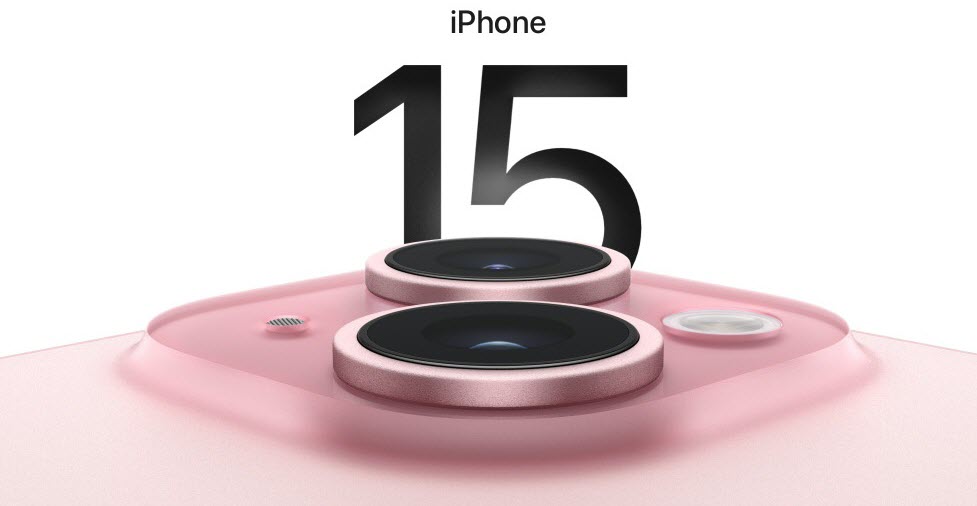
The iPhone 15 and Samsung Galaxy A54 feature different camera setups. The iPhone 15 sports a dual-camera system with a 48-megapixel primary sensor with an f/1.8 aperture and 2X optical zoom. The secondary lens on the iPhone 15 is a 12-megapixel ultra-wide-angle camera with an f/2.4 aperture. Both cameras are capable of recording 4K video at 60 frames per second.
On the Samsung Galaxy A54, there’s a triple rear camera setup consisting of a 50-megapixel primary sensor with an f/1.8 aperture, capable of recording 4K video at 30 frames per second. The secondary camera is a 12-megapixel ultra-wide-angle lens with an f/2.2 aperture, and the third sensor is a 5-megapixel macro camera with an f/2.4 aperture.
For selfies, the iPhone 15 uses a 12-megapixel front camera with an f/1.9 aperture, while the Galaxy A54 features a 32-megapixel front camera with an f/2.2 aperture. Both front cameras can record video in 4K, but the iPhone 15 can do so at a frame rate of 60 fps, while the Galaxy A54 is limited to 30 fps.
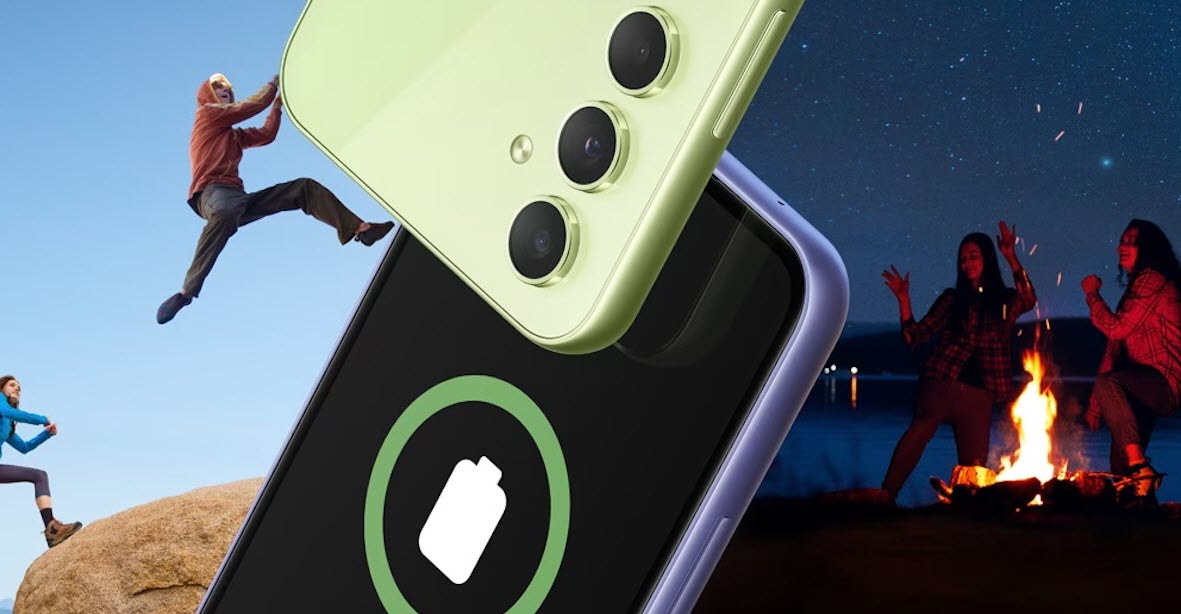
Let’s continue with the comparison of the Samsung Galaxy A54 vs iPhone 15. Now, let’s take a look at their batteries, where there are some notable differences. The Galaxy A54 has a larger battery with a capacity of 5,000 mAh. It also supports 25W wired fast charging. In contrast, the iPhone 15 has a 3,877 mAh battery with 20W wired fast charging, 15W MagSafe wireless charging, and 7.5W reverse wireless charging. Neither phone includes a charger in the box, but they both come with a charging cable. Both devices use a USB Type-C port for charging.
In terms of connectivity, both phones offer 5G, 4G LTE, dual-band Wi-Fi 802.11 a/b/g/n/ac/6, Bluetooth 5.3, and GPS with A-GPS and GLONASS. They also have NFC, but the iPhone 15 supports Apple Pay for contactless payments, while the Galaxy A54 supports Google Pay and Samsung Pay. One unique feature of the iPhone 15 is satellite connectivity, which allows you to send emergency messages to authorities even in areas without mobile coverage.
On the software front, the iPhone 15 runs iOS 17, while the Samsung Galaxy A54 runs Android 13 with One UI 5.1. Both phones come with dual stereo speakers and facial recognition. The iPhone 15 uses Face ID for biometric unlocking, while the Samsung phone features an in-display optical fingerprint reader. Additionally, both phones have water resistance, with the iPhone 15 rated at IP68 and the Galaxy A54 at IP67.
We’ve highlighted the differences between the Samsung Galaxy A54 and iPhone 15, so now let’s look at their prices and then determine which one is better and why.
The iPhone 15 has been officially priced at around 960 euros for the 128GB variantn. The Samsung Galaxy A54, on the other hand, can be purchased for around 340 euros and up in 2023. The price difference is quite substantial, with more than a 600 euro gap.
Now, with this in mind, we can say that the winner of this comparison between the iPhone 15 and Samsung Galaxy A54 is the iPhone 15, but only in terms of features.
The iPhone 15 is an overall more advanced device. While its display still features a 60Hz refresh rate, it excels in other display characteristics compared to the Galaxy A54. Its cameras are also on another level, delivering significantly better photo and video quality. Moreover, the A16 Bionic processor is among the best in the industry. It’s worth noting that the iPhone 15 lacks a microSD card slot for expandable storage, but it does come in a 512GB internal storage variant. The iPhone 15 also offers similar battery life to the Galaxy A54 while supporting MagSafe wireless charging and reverse wireless charging.
Additionally, the iPhone 15 boasts satellite connectivity, a feature the Galaxy A54 lacks, as mentioned earlier. It also features a more advanced and secure facial recognition system (Face ID) and comes with an IP68 rating for water resistance. Furthermore, it is considerably lighter and has a compact design, which many users find more appealing, although design preferences can be subjective.
So, considering all of the above, is the iPhone 15 better than the Samsung Galaxy A54? It depends. If we solely consider the features, the answer is a resounding “yes.” However, when it comes to the value for money, it’s clearly a “no.” As mentioned before, it all depends on your needs as a user and your budget.